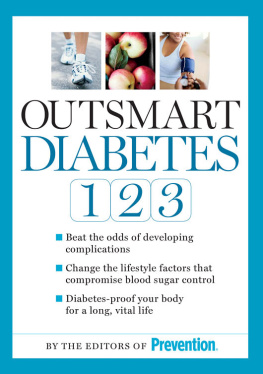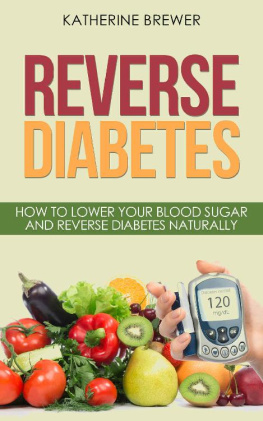This book is intended as a reference volume only, not as a medical manual. The information presented here is designed to help you make informed decisions about your health. It is not intended as a substitute for any treatment that may have been prescribed by your doctor. If you suspect that you have a medical problem, we urge you to seek competent medical care.
Mention of specific companies, organizations, or authorities in this book does not imply endorsement by the author or publisher, nor does mention of specific companies, organizations, or authorities imply their endorsement of this book, its author, or the publisher.
Internet addresses and telephone numbers were accurate at the time this book went to press.
DIABETES ought to come with its own instruction manual.
The diagnosis can be confusing enough; just what is diabetes anyway? More to the point, once youve got it, how do you keep it in check?
Answering these questions could easily, well, fill a book. This one is the culmination of hundreds of hours of interviewing experts and scouring the scientific literature, driven by a singular objective: to empower you and others who have diabetes not just to live with the disease, but to live beyond itthat is, to manage it so effectively that it has the least possible impact on your long-term health and quality of life.
Its true that diabetes isnt curableat least not yet. But as we learned from doctors, nurses, nutritionists, exercise physiologists, certified diabetes educators (CDEs), and other professionals who specialize in diabetes care, the disease is treatable and controllable. In the case of type 2, by far the most common form of diabetes (and our primary focus here), this usually means lifestyle changes, possibly in combination with medicationthough its worth noting that maintaining a healthy lifestyle can delay and even eliminate the need for drug therapy.
Of course, maintaining a healthy lifestyle takes effort. Even the most vigilant among us will have moments when our self-care gets a little lax. The trouble is, high blood sugar can start doing damagethe kind that leads to diabetes complicationslong before diabetes is even diagnosed.
Thats the reality check. But the opposite is also true: You can lower your risk of complications by stabilizing your blood sugar at a healthy level. The pages that follow provide plenty of nuts-and-bolts advice about nutrition, exercise, weight loss, sleep, stress reduction, and the myriad other factors that influence your blood sugar, along with an ample dose of encouragement and reassurance to help you stay on track.
For ease of use, weve organized this book into four sections. The introduction, Understanding Diabetes, provides a comprehensive overview of diabetesits prevalence, its most common forms, and its whole-body effects. Whether youre newly diagnosed or youre well into treatment, these chapters will give you a clear picture of the state of the science in diabetes management.
In Step 1, Outsmart Diabetes Complications, we take a closer look at how this one disease can contribute to other health problemsquite literally, from head to toe. Here you can assess your risk of the most common complications and learn strategies for slowing and possibly reversing any diabetes-related damage.
This leads us to Step 2, Navigate the Diabetes Danger Zones. You probably already know how your eating habits and your activity level can cause spikes and dips in your blood sugar readings. But did you know that stress, lack of sleep, and even your mood can influence both your blood sugar level and your ability to bring it into balance? Here well explore how these and other lifestyle factors can undermine diabetes management and what you can do to shore up your self-care efforts.
Step 3, Diabetes-Proof Your Life, presents the 10 fundamental principles that collectively can help ensure optimal diabetes control. Incorporate these guidelines into your lifestyle, and you can stave off the diseases more insidious effects and lay the foundation for a long, vital life.
This is what we mean when we talk about outsmarting diabetes: Armed with the most reliable information and the best tools, you can stay a step ahead of the disease. So lets get started!
INTRODUCTION
UNDERSTANDING DIABETES
ITS A RAINY SATURDAY MORNING IN NOVEMBER, and about 100 people are sitting in the auditorium of Mountainside Hospital in Montclair, New Jersey. Theyve come to learn about diabetes.
At the moment, the hospitals head of psychiatric services, Edward Latimer, MD, is onstage, discussing some of the emotional issues associated with diabetes. People who are recently diagnosed with the disease, he says, often go through the same stages of grief as someone who has experienced a deep personal loss: denial, anger, bargaining, depression, and, finally, acceptance.
Dr. Latimer opened his talk by explaining that he likes to engage his audiences in dialogue. True to his word, he interrupts his presentation to throw out a question to the crowd.
Whats depressing about diabetes? he asks.
Only a moment passes before hands raise and voices ring out in the darkened auditorium.
You have to stick yourself all the time, a woman near the back says.
You have to turn down food when you eat at somebodys house and try to explain to them that it isnt because you dont like what they cooked, says the man seated next to her.
The routine, says a woman near the front. Monitor, monitor, monitor. Watch this, watch that, dont eat this, dont eat that. It gets old after a while.
Another woman near the back shouts, The reactions of other people when they find out you have it!
An older woman with a cane, seated on the aisle, speaks quietly, and Dr. Latimer asks her to repeat her comment.
Im always worried about whats next, she says. Whats coming in the future?
Each of these comments is greeted with knowing nods of agreement and understanding around the auditorium.
Then Dr. Latimer calls on a man near the back of the room whos been waving his hand. Whats wrong with diabetes? the man asks. Everything!
The whole audience laughs and nods.
If youve been diagnosed with diabetes, you might be imagining yourself in that auditorium in New Jersey, empathizing with the comments of those around you and perhaps throwing out one or two of your own. Its true that the prospect of living with diabetes seems daunting at times. Its also true, as that spontaneous group therapy session illustrates, that many people share the same fears and frustrations about the disease.
What the audience learned from Dr. Latimer and the other doctors, nurses, and nutritionists who spoke that day is that there are ways to keep diabetes from disrupting their lives. They learned that there are strategies to effectively control the disease and limit its impact on their overall health and vitality. They learned, in other words, that there is hope.
We created this resource for you, offering insight and guidance from dozens of health professionals who specialize in diabetes management, because we, too, believe that you can outsmart diabetes. Yes, its a serious disease, but with proper self-care measures, you can minimize its effects on your body as well as your lifestyle. Well show you how.
But first, lets take a closer look at the numbers behind diabetes. As youll soon see, its touching people of all stripesyoung and old, male and female, all ethnicities, all incomes. Its implications for us, both as individuals and as a nation, have made it one of our most urgent health priorities for the early 21st century.
Diabetes by the Numbers









![Sheri Colberg-Ochs [SHERI R COLBERG] - The 7 step diabetes fitness plan : living well and being fit with diabetes, no matter your weight](/uploads/posts/book/102363/thumbs/sheri-colberg-ochs-sheri-r-colberg-the-7-step.jpg)


